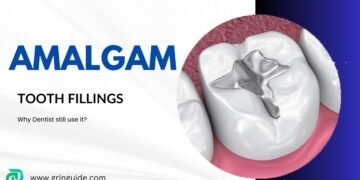Table of Contents
Introduction
Composite resin fillings, often referred to as dental composites or composite fillings, represent a significant advancement in modern dentistry. These fillings are made from a mixture of fine glass and plastic particles, which results in a material that is both durable and aesthetically pleasing. Unlike traditional amalgam fillings, which are composed of metals such as mercury, silver, and tin, composite resin fillings are designed to blend seamlessly with the natural color of teeth, offering a more discreet and visually appealing solution.
The primary purpose of composite dental fillings is to restore the function, integrity, and morphology of missing tooth structure resulting from decay or trauma. These fillings can be used to repair cavities, cracks, or fractures in teeth. Due to their versatility, composite resin fillings are suitable for both anterior (front) and posterior (back) teeth, making them a popular choice among dental professionals and patients alike.
One of the key reasons composite fillings have become the preferred alternative to amalgam fillings is their ability to bond directly to the tooth structure. This adhesion process not only enhances the strength and durability of the filling but also allows for a more conservative approach to tooth preparation. Less removal of healthy tooth structure is required, preserving more of the natural tooth.
Aesthetic benefits are another significant advantage of composite resin fillings. The material can be carefully matched to the shade of the patient’s natural teeth, providing a virtually invisible restoration. This feature is particularly important for fillings in visible areas of the mouth, where maintaining a natural appearance is crucial.
In conclusion, composite resin fillings offer a combination of functional benefits and aesthetic appeal, making them a highly effective and preferred solution in contemporary dental practice. Their ability to blend with natural teeth, coupled with their strength and durability, underscores their growing popularity in restorative dentistry.
The Composition of Composite Resin Fillings
Composite resin fillings are a popular choice for dental restorations due to their aesthetic appeal and durability. The core composition of these fillings is a mixture of plastic (resin) and finely ground glass particles. This combination, meticulously engineered, offers both the strength required to withstand the forces of chewing and the translucency needed to mimic the natural appearance of tooth enamel.
The plastic component of the composite resin is typically an acrylic resin, which provides the matrix in which the glass particles are embedded. These glass particles, often made from silicon dioxide, contribute significantly to the composite filling’s strength and wear resistance. Additionally, the glass particles impart a level of translucency to the filling, which enhances its ability to blend seamlessly with the natural tooth structure.
Over the years, advancements in dental materials have led to significant improvements in the quality of composite resin fillings. Innovations such as the development of nano-composites have resulted in materials that offer superior strength and enhanced polishability. These advancements ensure that composite dental fillings not only last longer but also maintain their appearance over time.
Furthermore, modern composite resins exhibit excellent bonding properties, which allow them to adhere effectively to the tooth structure. This strong bond minimizes the risk of leakage and secondary decay, thereby contributing to the long-term success of the restoration. The continued evolution of composite materials is driven by ongoing research and technological advancements, ensuring that patients receive the highest quality dental care.
In summary, the composition of composite resin fillings—comprising a blend of plastic and fine glass particles—provides a durable and visually appealing solution for dental restorations. The advancements in material science have elevated the performance and reliability of these fillings, making them a preferred choice for both dentists and patients alike.
Advantages of Composite Resin Fillings
Composite resin fillings offer numerous advantages, making them a popular choice in modern dentistry. One of the most notable benefits is their natural appearance. Unlike amalgam fillings, which are metallic and often noticeable, composite resin fillings can be closely matched to the color of your existing teeth. This makes them particularly advantageous for dental fillings in visible areas, such as the front teeth, where aesthetics are a primary concern.
Another significant advantage is the ability of composite dental fillings to bond directly to the tooth structure. The adhesive bonding technique used with composite resin creates a strong bond between the filling and the natural tooth. This not only helps to support the remaining tooth structure but also reduces the likelihood of the filling coming loose. This direct bonding capability also means that composite resin fillings can be used to repair a variety of dental issues, ranging from minor chips to larger cavities.
The versatility of composite fillings is another key benefit. They are suitable for treating different types of cavities, whether they occur on the front or back teeth. Their adaptability makes them an excellent choice for patients with diverse dental needs. Additionally, composite resin fillings can be used in restorative procedures, such as rebuilding worn teeth or closing gaps between teeth, further enhancing their utility.
Lastly, composite resin fillings require the removal of a minimal amount of tooth structure compared to traditional amalgam fillings. This conservative approach preserves more of the natural tooth, contributing to the overall health and longevity of the tooth. The ability to maintain more of the original tooth structure is particularly beneficial in preventing future dental issues and ensuring a more robust and durable restoration.
The Procedure for Getting Composite Resin Fillings
The process of getting a composite dental filling is a meticulous yet straightforward procedure designed to restore the function and aesthetics of a tooth. It typically begins with an initial consultation, where the dentist conducts a thorough examination to assess the extent of tooth decay or damage. During this visit, X-rays may be taken to get a precise view of the affected area.
Once the necessity for a composite filling is confirmed, the dentist will proceed with the tooth preparation. This step involves numbing the area around the tooth with a local anesthetic to ensure a pain-free experience. Using specialized dental instruments, the dentist will then remove the decayed or damaged portion of the tooth. It is crucial to eliminate all compromised tissue to prevent further decay and to provide a solid foundation for the composite material.
After the tooth is prepared, the dentist will apply the composite resin in layers. Before each layer is added, the tooth surface is etched with a mild acidic solution to create a rough texture, which helps the composite adhere more effectively. The composite resin, which matches the natural color of the tooth, is then carefully placed into the cavity. Each layer of the composite material is hardened, or cured, using a special light that emits blue wavelengths. This curing process ensures that the filling becomes durable and securely bonded to the tooth structure.

Once all the layers are in place and fully cured, the dentist will shape and polish the composite filling to match the contours of the natural tooth. The final shaping is essential for ensuring that the filling fits comfortably with the patient’s bite and that there are no rough edges. Polishing the composite filling not only enhances its appearance but also helps to prevent staining and wear over time.
Overall, the procedure for getting composite resin fillings is efficient and typically completed in a single appointment. Patients can expect to leave the dental office with a restored tooth that is both functional and aesthetically pleasing.
Durability and Lifespan of Composite Resin Fillings
The durability and lifespan of composite resin fillings are influenced by various factors, which include the location of the filling in the mouth, the patient’s oral hygiene practices, and dietary habits. Composite dental fillings, known for their aesthetic appeal and versatile application, typically last between five to seven years. However, with proper care, they can last even longer.
One key factor affecting the longevity of composite resin fillings is their location within the mouth. Fillings on the chewing surfaces of molars tend to experience more wear and tear due to the high pressure exerted during mastication. Consequently, these fillings may have a shorter lifespan compared to those placed on less stressed areas like the front teeth. Additionally, the size and depth of the filling also play a crucial role in its longevity, with larger and deeper fillings being more susceptible to damage over time.
Oral hygiene practices significantly impact the durability of composite fillings. Good oral hygiene, including regular brushing, flossing, and dental check-ups, can help prevent decay around the filled area and ensure the filling remains intact. Poor oral hygiene, on the other hand, can lead to secondary caries, which can compromise the structural integrity of the composite filling.
Dietary habits are another important consideration. Consuming a diet high in sugar and acidic foods can accelerate the wear and degradation of composite resin fillings. Conversely, a balanced diet rich in nutrients can support oral health and contribute to the longevity of composite fillings.
When comparing the durability of composite fillings to other types of fillings, such as amalgam or gold, composites generally have a shorter lifespan. Amalgam fillings, for instance, can last up to 15 years, while gold fillings can last even longer. However, composite fillings offer superior aesthetic benefits and are less likely to cause allergic reactions.
To extend the lifespan of composite resin fillings, patients should maintain excellent oral hygiene, avoid excessive consumption of sugary and acidic foods, and attend regular dental check-ups. By following these guidelines, composite fillings can provide a durable and aesthetically pleasing solution for dental restoration.
Potential Risks and Disadvantages
While composite resin fillings offer numerous benefits, it is important to be aware of the potential risks and disadvantages associated with them. One key consideration is the durability of the filling material. Unlike amalgam fillings, which are known for their strength and longevity, composite fillings may wear down over time, especially in areas subjected to heavy chewing forces. This could necessitate more frequent replacements compared to their amalgam counterparts.
Another potential downside is the increased sensitivity some patients might experience after getting a composite dental filling. The placement process can sometimes lead to heightened sensitivity to hot and cold temperatures, although this is typically temporary and subsides as the tooth adjusts. However, this sensitivity could be more pronounced in people with preexisting dental issues or those who have received extensive dental work.
Furthermore, the procedure for placing composite resin fillings is more technique-sensitive and requires greater precision from the dentist. Unlike amalgam fillings, which can be more forgiving in terms of placement, composite fillings need a dry and clean environment to adhere properly to the tooth structure. This meticulous process can sometimes result in longer appointment times and might require more expertise from the dental practitioner.
Additionally, composite fillings tend to be more expensive than amalgam fillings due to the advanced materials and techniques involved. This cost factor can be a significant consideration for patients when choosing the type of filling that best suits their needs and budget.
Despite these potential downsides, composite resin fillings remain a popular choice due to their aesthetic appeal and ability to closely match the natural color of teeth. However, being informed about the potential risks and disadvantages can help patients make a more balanced and informed decision regarding their dental care.
Cost Considerations
When considering dental treatments, cost is often a significant factor. Composite resin fillings, while generally more expensive than traditional amalgam fillings, offer several advantages that can justify the additional cost for many patients. The price difference is primarily attributed to the materials used and the time required for the procedure. Composite fillings require a more meticulous application process, allowing for a more natural appearance and better fit within the tooth structure.
On average, the cost of composite resin fillings can range from $90 to $250 per tooth, depending on the size and location of the cavity. In contrast, amalgam fillings typically cost between $50 and $150 per tooth. While composite fillings are more expensive upfront, their aesthetic and functional benefits often make them a worthwhile investment. They blend seamlessly with the natural color of teeth, providing a more discreet and visually pleasing outcome compared to the metallic appearance of amalgam fillings.
Insurance coverage for composite fillings varies depending on the policy. Many dental insurance plans cover composite fillings at the same rate as amalgam fillings, particularly for front teeth where aesthetics are a primary concern. However, some policies may provide reduced coverage for composite fillings in molars or back teeth, considering them as an elective or cosmetic procedure. It is essential to review your insurance plan and discuss coverage options with your provider to avoid unexpected out-of-pocket expenses.
Additionally, the long-term value of composite resin fillings should be taken into account. They bond directly to the tooth, which can strengthen the remaining tooth structure and reduce the risk of further decay. Composite fillings are also less likely to cause cracks or fractures, contributing to their durability and longevity. Considering these benefits, many patients find that the initial higher cost is offset by the reduced need for future dental work and the enhanced appearance of their smile.
Maintaining and Caring for Composite Resin Fillings
Proper maintenance and care are essential to ensure the longevity of composite resin fillings. These fillings, while durable, require a proactive approach to oral hygiene and lifestyle habits to keep them in optimal condition over time. Here are some practical tips to help you maintain your composite dental fillings effectively.
First and foremost, maintaining good oral hygiene is crucial. Brush your teeth at least twice a day with a fluoride toothpaste and use dental floss daily to remove food particles and plaque from between your teeth and around the fillings. Consider using an antibacterial mouthwash to further reduce the risk of decay and gum disease. Consistent and thorough oral hygiene practices help prevent issues that could compromise your composite fillings.
Another important aspect is to avoid foods and habits that can damage the fillings. Composite resin fillings, while strong, are not immune to wear and tear. Avoid chewing on hard objects like ice, pens, or your fingernails, as these can cause the fillings to crack or chip. Similarly, limit the intake of very hard or sticky foods that could put undue stress on the fillings. Foods and beverages with high acidity levels, such as citrus fruits and sodas, can also erode the composite material over time.
Regular dental check-ups are indispensable for maintaining composite fillings. Schedule visits to your dentist at least twice a year for professional cleanings and examinations. During these appointments, your dentist can check the condition of your fillings, identify any potential issues early on, and provide appropriate treatments if necessary. Early detection and intervention can prevent more serious problems and extend the life of your composite fillings.
By following these guidelines, you can significantly enhance the durability and functionality of your composite resin fillings, ensuring that they continue to serve you well for years to come.
Conclusion
Composite fillings are a reliable and safe option for dental restorations. They provide a natural appearance and can last many years with proper care. If you have any concerns or need further information, consult with your dentist to determine the best treatment for your dental needs.
FAQs
-
How Long Do Composite Fillings Last?
The lifespan of composite fillings can vary based on several factors such as oral hygiene, diet, and the location of the filling. Generally, composite fillings last between 5 to 10 years. Regular dental check-ups and proper care can extend their longevity, ensuring your teeth remain healthy and functional.
-
Are Composite Fillings Safe?
Yes, composite fillings are safe. They are made from a mixture of plastic and fine glass particles, which do not pose health risks. Concerns about the presence of BPA (Bisphenol A) in dental composites have been addressed by manufacturers. Most modern composite resins are BPA-free, making them a safe option for dental restorations.
-
Effectiveness of Composite Fillings
Composite fillings are highly effective for dental restorations. They bond well to the tooth structure, providing strong and durable repairs. Additionally, their tooth-colored appearance makes them aesthetically pleasing, blending seamlessly with natural teeth. Composite resin is an excellent choice for both front and back teeth.
-
Post-Treatment Care
After getting a composite filling, you can eat once the anesthesia wears off. It is advisable to avoid very hard or sticky foods initially to prevent dislodging the filling. Maintaining good oral hygiene and avoiding habits like teeth grinding can help prolong the life of your composite fillings.









